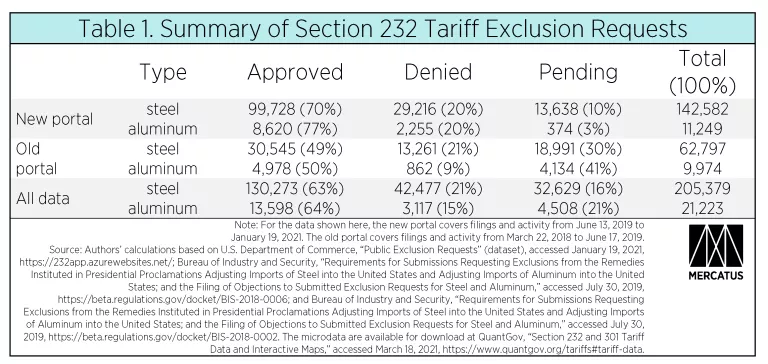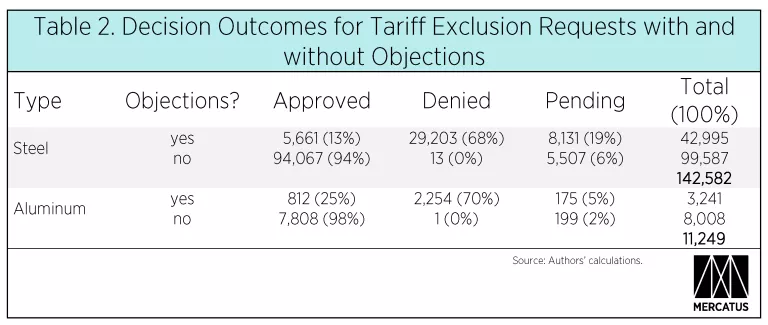- | Expert Commentary Expert Commentary
- |
On the Third Anniversary of the Steel and Aluminum Tariffs, Things Have Not Gone as Planned
The huge number of tariff exclusion requests show that American manufacturers need more than domestic steel and aluminum producers can provide
Three years ago, when the section 232 steel and aluminum tariffs were first imposed, the Trump administration made clear that they were aimed at countering foreign subsidies and overcapacity. Indeed, the Commerce Department indicated they would administer a tariff exclusion request (TER) process with an eye to minimizing undue impact on downstream industries, such as U.S. manufacturers that use steel and aluminum in their production processes. The department also estimated that it would receive 4,500 exclusion requests from the steel tariffs and 1,500 from the aluminum tariffs. But as of January 19, U.S. manufacturers have filed for relief over 225,000 times through the Section 232 program’s “exclusion request” process.
The first table displays the total filings to date and combines the data from the old portal at regulations.gov and the new internet portal to house exclusion data that was created in June 2019 and replaced the old portal to give a full picture of exclusion activity. There has been a total of 205,379 steel exclusion requests, of which 63% have been approved, 21% have been denied and 16% remain pending. For aluminum, there have been 21,223 exclusion requests, with 64% approved, 15% denied and 21% pending.

Since our last update in Nov. 2020, there have been 35,027 new steel tariff exclusion requests and 1,916 new aluminum tariff exclusion requests filings. These figures cover September 18, 2020 to January 19, 2021 and represent a 7.7% decline in steel filings and a 10.1% decrease in aluminum filings from the previous four-month period.
Objections Still Matter
A tariff exclusion request by a U.S. manufacturer is far less likely to get approved if it is followed by an objection from a steel or aluminum producer. Of the TERs that had an objection, only 13% of steel TERs and 25% of aluminum TERs were approved. In contrast, of the TERs with no objection, 94% of steel and 98% of aluminum were approved.

Some exclusion requests have prompted multiple objections. The data suggest that while one objection is not insurmountable, multiple objections are difficult to overcome. For steel TERs, the denial rate goes from 64% with one objection to 81% with multiple objections. For aluminum TERs, the denial rate jumps from 57% with one objection to 91% with more than one.
In addition, renewal requests are more likely to get approved than new requests, not surprisingly. For steel, between 75% and 78% (the spread in this and the following sentence is due to reporting ambiguities) of renewals are approved, compared with 66% of new requests. For aluminum, between 84% and 92% of renewals are approved, compared with 70% new requests. All told, approximately 20% of renewal requests for steel TERs are denied, and 15% of renewal requests for aluminum TERs are denied.
The Objection Process Is Messy and Lacks Transparency
Meanwhile, the TER process has been plagued with procedural difficulties. In a January 2021 report, the Office of Inspector General (OIG) of the Department of Commerce found that the exclusion process lacks transparency and that many decisions are based on incomplete and inaccurate information. Specifically, there were cases in which a subject matter expert’s recommendation was not followed by Bureau of Industry and Security (BIS) – which is charged with processing TERs – without providing any clear reasoning or documentation.
We have found that under the existing system, an objection is nearly cost free for domestic steel and aluminum producers. Not surprisingly, objection filings have become increasingly excessive, and producers object to even small quantities of imports. Producers also often file numerous objections as soon as the new requests for exclusions are filed, only to later withdraw some of them.
In cases where steel and aluminum producers do not have the technical capacity to make their products to specification or any genuine intent to meet a customer’s demand, the exclusion process benefits the producers but can cause undue or excessive harm to U.S. manufacturers. Consequently, the objection process can result in the opposite of the intent of the tariff exclusion process.
Every objection filed, regardless of whether it is later withdrawn, can create costly delays for U.S. manufacturers. The OIG reported on page 13 of their audit that 96% of exclusion requests with an objection or objections are processed late, compared to 33% for those without any objections.
Since June 2019, 762 firms have asked for one or more steel tariff exemptions, and 218 firms have asked for one or more aluminum tariff exemptions. The top 15 filers account for at least half of all requests. Among the largest filers, there are starkly different outcomes. On steel, pipe-manufacturer Tubos Reunidos America (6,633 TERs) has a 96% approval rate, while Alloy Tool Steel (7,198 TERs) has only a 23% approval rate. On aluminum, Sigma Electric Manufacturing (844 TERs) has won 100% approval, while stainless steel distributer Spectrum Metals was successful in only 36% of its requests.
Requestors are asked to provide an explanation for their exclusion request. Options include insufficient U.S. availability, no U.S. production, national security or other. Just looking at this piece of data, and not controlling for other factors, “No U.S. Production” yielded the highest approval rating for steel, while “National Security Requirement” yielded the highest approval rating for aluminum.

Micromanaging Supply Chains Is Tough
During the three years that this process has been in place, both American steel and aluminum producers as well as manufacturers have found ways to increase their likelihood of success. For instance, the U.S. manufacturer may contact a producer or producers before filing a TER to confirm whether they can supply the steel or aluminum they need. If producers state they cannot fulfill an order, then a manufacturer might use that correspondence in its request filing as proof. Or a producer may immediately and blindly file objections to requests for exclusions on all products that they may be able to produce, including at some point in the future.
Meanwhile, the Commerce Department may be finding that micromanaging supply chains is tough because for each rule or regulation, however well intended, there are unintended consequences. Each side has incentives to game the system. The difference is that U.S. manufacturers are trying to procure much-needed inputs at prices offered to their competitors abroad. In contrast, steel and aluminum producers are trying to keep U.S. prices high and boost their own industrial production capacity—all on the backs of U.S. manufacturers.
Incoming Commerce Secretary Gina Raimondo recently indicated that the tariffs were effective, implying they would stay in place for now. As Bob Tita and William Mauldin of the Wall Street Journal reported last October, however, the tariffs may have boosted prices for a while, but there has not been the promised revival of the U.S. steel sector. Still, if the Biden administration keeps the tariffs in place, they should take the opportunity to make the process more efficient for all parties involved and limit downstream costs for manufacturers. We offered three ways to improve the process last summer and repeat them here:
- Require objecting steel or aluminum producers to demonstrate and prove (1) that they are qualified suppliers for the specific product in the original request and (2) that they can fulfill the request with the technical product specifications in no fewer than, say, 90 days. If suppliers cannot prove that they are qualified suppliers of the product with the correct technical product specification, then their objections should be disregarded.
- Require objecting producers to file a progress report midway through the 90-day fulfillment period to verify that production is on track to meet production targets. If no midpoint progress report is filed, then the objection is disregarded, and objecting producers should be required to pay manufacturers the amount of import duties paid plus interest.
- Require objecting producers to demonstrate that the subject good was produced in the targeted time and offered for sale to the manufacturer. If the producer cannot make the demonstration or if the manufacturer indicates that the sale was not made, then the objection is disregarded and the producers should be required to compensate the manufacturer the amount of import duties paid plus interest.
With the section 232 steel and aluminum tariffs, the U.S. government is essentially asking U.S. manufacturers to compensate American steel and aluminum for foreign subsidies and overcapacity. That is a heavy lift for U.S. manufacturers. They need access to competitively priced inputs in order to compete here at home and abroad. There is no evidence that foreign subsidies and overcapacity are dissipating. The real question for the Biden administration is: Will these tariffs stay on indefinitely, and to what end?